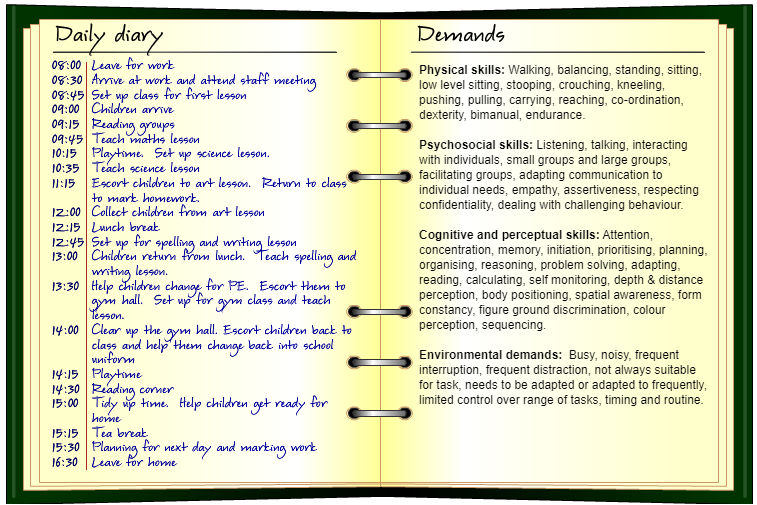- Stroke may affect any or all of the physical, cognitive, perceptual and psychosocial skills required of us at work, and a worker is more likely to return to work successfully where there is a good fit between their abilities, the demands of the work tasks and the work environment.
- A supported phased return to work, at the right time is likely to positively impact the individual’s health and wellbeing due to the financial, social and psychological benefits.
- Effective return to work planning requires both work focussed health care and an accommodating employer.
- Health care professionals can inform and guide return to work by using their problem solving skills, condition knowledge and rapport building skills.
- Many people will return to work successfully after a stroke, although this may not always be to full-time, paid employment.
Category: Advancing Modules
Outcome 6 months later
 Rosemary has now been back at work for 10 months. She is working 26 hours a week covering specific classes and has a mentoring role for junior staff. Reducing the physical and cognitive demands of the job has enabled Rosemary to manage her fatigue more effectively and she notes that her communication has improved as a result.
Rosemary has now been back at work for 10 months. She is working 26 hours a week covering specific classes and has a mentoring role for junior staff. Reducing the physical and cognitive demands of the job has enabled Rosemary to manage her fatigue more effectively and she notes that her communication has improved as a result.
Although Rosemary’s salary is reduced, she is in receipt of benefits which have helped with the shortfall.
Rosemary remains a valued member of the school teaching team.
Review 4 months later
- You see Rosemary for review four months later. Following a phased return to work she tells you that she is now back at work full-time but is very fatigued and notes her communication difficulties are more evident.
- You suggest she talk to her employer and she returns to the OHS, who recommend that she reduce her hours.
- Rosemary’s employer identifies a role for her in teaching a specific specialist subject, covering for other teachers and mentoring junior staff. This allows Rosemary to reduce her work hours, work more flexibly and reduces the amount of planning and organisation required.
Reasonable adjustments for Rosemary
We know that Rosemary has some ongoing functional difficulties after her stroke, including:
- Mobility – she uses one stick outdoors
- Arm function – she finds it difficult to use her arm above shoulder level
- Fatigue – she fatigues readily during daily activities
- Reading – she takes a little longer than she used to
- Minor expressive aphasia – when she is tired she sometimes has trouble finding the right words
Considering what you know about Rosemary’s abilities, the demands of her job and the legislation to support her to return to work, what adjustments do you think might be reasonable for her?
If an employer does not agree to make adjustments, it may be necessary for the employee to raise a grievance or take this further. It is ultimately the decision of an employment tribunal to decide reasonableness. Further support can be found via Citizens Advice or ACAS.
Results of the job analysis
Rosemary’s job is very complex. The tasks and environment place a high demand on her physically, cognitively and psychosocially. Rosemary may be less able to cope with these demands or to adapt herself to the environment following her stroke. To enable her to return to work, some adjustment is likely to be needed.

Rosemary’s job is very complex. The tasks and environment place a high demand on her physically, cognitively and psychosocially. Rosemary may be less able to cope with these demands or to adapt herself to the environment following her stroke. To enable her to return to work, some adjustment is likely to be needed.
Planning Rosemary’s return to work
Following discussion with Rosemary, she agrees to contact her employer planning for her to return to work. They arrange for her to attend their Occupational Health Service (OHS).
- At her first appointment, Rosemary meets with an Occupational Health Advisor to discuss returning to work. In order to decide how best to support her to do so, the Advisor asks her permission to contact her GP for a report detailing her current health, physical and functional ability. She talks to Rosemary about her job and arranges for a job analysis visit to be carried out at Rosemary’s workplace.
- A job analysis is a systematic approach to identify and describe the demands a job places on a worker. It considers the activities performed, the outcome, services and materials produced, the skills and aptitudes required, and the work environment.
- A worker is more likely to be able to perform their job successfully where there is a good fit between their abilities and the job demands.
Comparing the information about Rosemary’s functional ability with that of the demands of the work tasks and work environment will help to determine whether there is a good fit between what Rosemary can do and what she needs to be able to do at work. - It can also help identify what needs to change to improve that fit. This may mean changing the way Rosemary does things, changing the equipment she uses or changing the work environment.
Reasonable adjustments
Legal Framework
What legislation and organisations exist to support Rosemary to return to work?
Who can help Rosemary return to work?
The Vocational Rehabilitation Association (2008) defines Vocational Rehabilitation as “a process, which enables persons with functional, psychological, developmental, cognitive, and emotional impairments or health conditions to overcome barriers to accessing, maintaining or returning to employment or other useful occupation”. A wide range of Interventions may be provided by a range of appropriately trained and experienced professionals who may be based in the public, voluntary or private sector (Sainsbury Centre for Mental Health 2008).
You have already started to talk to Rosemary and her employer about return to work. You may be able to use your understanding of her stroke and rehabilitation to inform reasonable adjustments or strategies to help her manage in work. Who else can support?


